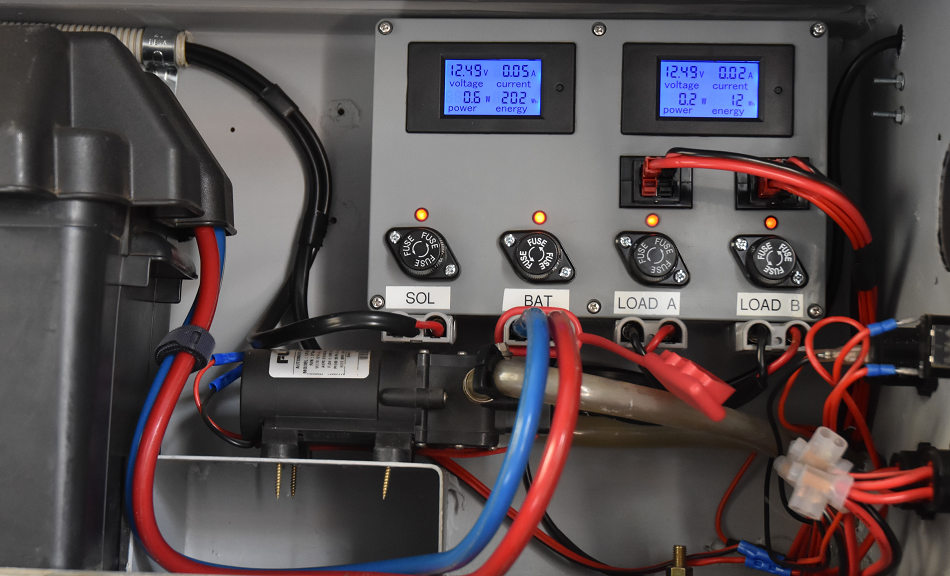|
Navigation
Contact Details
Peter Miles
Northam, Western Australia
QRZ Page: VK6YSF
Email

Social
Media


Buy me a coffee
|
If you found information on this site interesting, beneficial, or learned something new, please consider buying me a cup of coffee by clicking the coffee cup below.
It helps keep the website going and is greatly appreciated.

|
|
|
|
DC DISTRIBUTION FOR OFF-GRID CAMPING 12V
distribution
for managing solar off-grid camping
Camping off-grid requires a reliable power system to keep essential
devices running consistently. A well-designed 12V DC distribution
board, even if simple, provides efficient power management, ensuring
that the battery, solar panel, and connected loads work reliably
together for extended periods. This set-up allows campers to maintain
power independence without relying on external sources.

Photo
1
Camp
set up.

Photo
2
DC distribution board and
water pump.

Fig
1 Schematic diagram of the
DC distribution board and related equipment.

Photo
3 DC distribution board
construction showing the metering shuts to the left and negative and
positive bus centre.
Camping off-grid requires a reliable power system to keep essential
devices running consistently. A well-designed 12V DC distribution
board, even if simple, provides efficient power management, ensuring
that the battery, solar panel, and connected loads work reliably
together for extended periods. This
set-up
allows campers to maintain
power independence without relying on external sources.
The core of the system is a 97Ah 12V lead-acid battery, which serves as
the primary power source. Chosen for its sufficient capacity, this
battery is also compatible with my 4WD, allowing for easy
interchange ability
during extended trips or emergencies. To maintain
a steady charge, a 160-watt solar panel is integrated into the
system. This solar panel connects via a 50A Anderson connector,
enabling the use of alternative or additional solar panels as
needed.
Monitoring the charging process is crucial for
optimising
power usage,
which is why a DC Multifunction Digital Power Meter Energy Monitor
Module is included. This module provides real-time data on voltage,
current, power, and energy generated by the solar panel, enabling
users to make informed decisions about their energy consumption.
In addition to monitoring the charging process, the system also includes
a second DC Multifunction Digital Power Meter Energy Monitor Module
to track total load performance. By measuring energy used by connected devices, this module helps
manage the system load, ensuring that excessive power consumption is
avoided.
Basically,
so long as more power is generated in Watt hours than consumed over
a period of days, power is available indefinitely.
|

|

|
| Photo
4 DC
Multifunction Digital Power Meter |
Photo
5 DC
Multifunction Digital Power Meter
wiring |
DC
Multifunction Digital Power Meter features.
1.
Electrical parameter measurement function - voltage, current, power
(Watts), energy (Watt Hours).
2. Overload
alarm function (overpower alarm threshold, the backlight and power
flicker tips).
3. The
power alarm threshold pre-set function (can set up their own power
alarm threshold).
4.
Power-down data storage function.
5.
Large-screen LCD screen full display function (display voltage,
current, active power, power).
6.
Backlight.
Circuit
features
The D1 15A Schottky diode
(STPS1545F) is included in the circuit to prevent load current from
being drawn through the charging input. This protects against
situations where the trailer is connected to a car and the engine is
started, which could cause excessive current to flow through wiring
not designed to handle such a load. Note: The STPS1545F Schottky diode
is mounted on a heatsink.
A Schottky diode, also known as a
hot-carrier diode, is a type of semiconductor diode with very fast
switching speed and low forward voltage drop compared to standard PN-junction
diodes.
Schottky diode
Characteristics
| Feature |
Schottky
Diode |
Standard
Diode (e.g., 1N4007) |
| Forward
voltage drop |
~0.15V
to 0.45V |
~0.6V
to 1.0V |
| Switching
speed |
Very
fast (nanoseconds) |
Slower
(microseconds) |
| Reverse
recovery time |
Very
short |
Longer |
| Leakage
current |
Higher |
Lower |
| Temperature
limit |
Usually
lower (max ~150°C) |
Higher |
Common
Applications
-
Power
supplies: Used in switch-mode power supplies (SMPS) to improve efficiency.
-
Reverse
polarity protection: The low forward voltage drop reduces wasted power.
-
Solar
systems: Prevent backflow from batteries to panels.
-
RF and
logic circuits: Where fast switching and low noise are needed.
LED
Indicators:
-
LED
1 lights up when a charging voltage is present, whether from solar
panels, the car's supply circuit, or another power source. If LED 1
is not lit, there is either no charging voltage or Fuse 1 has blown.
-
LED
2 indicates the presence of battery voltage. If LED 2 is off, it
means Fuse 2 has blown. In this case, LEDs 3 and 4 will also be off.
-
LEDs
3 and 4 light up when supply voltage is available for the load
circuits. If either LED 3 or 4 is off, the corresponding fuse has
likely blown, possibly due to an excessive load or a fault in an
external circuit.
The power distribution system is designed to accommodate different power
requirements. High-demand devices such as fridges or inverters
connect via 50A Anderson connectors, which handle high-current loads
efficiently. For lower-powered devices such as LED lighting, USB
chargers, or pumps, smaller 30A Anderson connectors are used,
providing a more practical solution for smaller loads.
A well-planned 12V DC distribution board is an essential component of any
off-grid camping experience. With a robust battery, efficient solar
charging, real-time energy monitoring, and secure power
distribution, this system offers a seamless way to manage power
needs. Whether running a fridge, charging devices, or powering
lights, campers can confidently rely on this
set-up
for extended
off-grid adventures.
TOP
OF PAGE
Page initiated 19
February, 2025
Page
last revised 20 June, 2025
|
|
|
|
|
Space Weather
https://www.swpc.noaa.gov/
Notice Board
|
VK6YSF JS8Call and
Olivia 8/250 operations.
Current activity is generally
focused - though not restricted to - JS8Call operations on the 20m, 30m, and 40m bands.
Currently
there is a particular emphasis on JS8Call on the 10 and 12 m band between 00:00 and 12:00 Z, often extending beyond this period.
Olivia 8/250 is used occasionally on the 20m band.
Proposed
band and mode activity
is often communicated on HamSpots: https://hamspots.net/js8/
or my profile on
X: https://x.com/vk6ysf97230
.
Feel free to contact me to discuss or arrange a schedule for a contact.
Post
date: 7 December 2025
|
|
Western Australian SSTV net
Popular
Western Australian SSTV net for both digital and anolog SSTV.
Generally
found at 7214.0kHz LSB every afternoon from 08:00 UTC (4:00pm WST)
For more
details: https://www.wasstv.net/wasstv.net/index.html
Post
date: 8 December 2025
|
|
VK6MJM LF (136kHz) and MF (474kHz) Beacon
VK6MJM is a LF/MF station
located in Manjimup, Western Australia.
Common Mode: FST4W 300 (Similar to WSPR)
Note:
other modes and sub-modes may be used.
Station details were presented by
Peter Hall (VK6HP) at PerthTech 2024.Presentation PDF: Peter
Hall VK6HP at PerthTech
QRZ Page: VK6MJM
on QRZ.com
Post
date: 10 March 2025
|
|
\ |
|
|